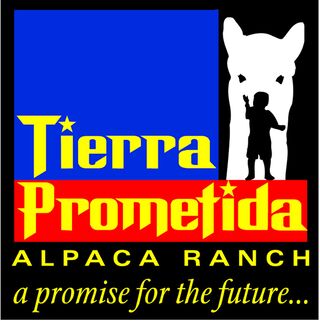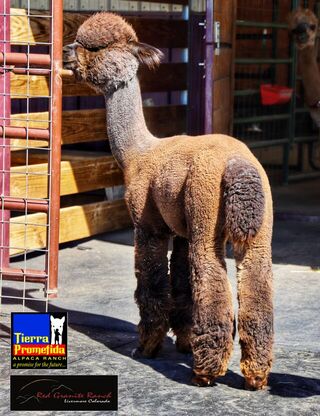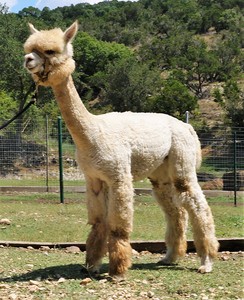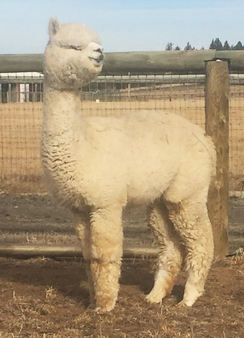Alpaca Care
Cool Ideas for Hot Summer Days
One of the most common questions that we get asked by visitors to our farm is: "How do alpacas do in this
heat?"
That was one of our biggest concerns about raising alpacas in the Central Texas Hill Country, and I have to say, that we have been pleasantly surprised. We have always taken special precautions when the weather begins to warm up, but we have been very impressed with the adaptability of these wonderful animals. Obviously, the big concern about heat, is the possibility of heat stress or hyperthermia. Hyperthermia occurs when the body temperature is above normal and can cause irreparable damage to muscles and kidneys. The risk of hyperthermia is highest when heat and humidity are both high and is associated with the heat index..* The risk of hyperthermia is also increased in overweight animals and in animals with increased activity or stress i.e.: breeding, pacing with weaning, fighting, herd health days, or active running and playing.
* The heat index is calculated by Temp (degrees F) + %Humidity
- <120 No Problem
- 150 Caution: avoid stress
- >180 Danger!! Observe closely
Hyperthermia is an emergency situation that when dealt with early is treatable, but is avoidable with some common sense preparations.
- Shear every year in April or May. In some heavily fibered animals, you may need to shear the belly later in the summer. Over the past 4 years, we have opted to re-shear all of our cria and shear any born after shearing at the end of June or beginning of July. (And they still have plenty of fleece for the fall shows!)
- Provide plenty of clean drinking water that is available without competition.
- Provide plenty of shade-either in open, well ventilated shelters, or in tree covered areas. Make sure there is plenty of room for everyone to have their personal space. This helps to avoid stress and fighting.
- Moving air helps to conduct heat away. Obviously, the lightly fibered area on the belly will allow heat to dissipate more easily and so ventilation needs to get under the animals, not just over them. We use fans, natural breeze, and evaporative coolers to ventilate and lower the air temperature.
- On some of the hottest days, wading pools or wetting their bellies is a nice way for the animals to cool down. Staying wet, however, can rot the fiber off their bellies and legs, so be judicious.
- Alternatively, create an area with coarse sand or pea-gravel that you can keep wet.
- Sand and cement flooring will be cooler than lying in a bed of straw or hay which can block ventilation to the belly.
- Good nutrition, not over-nutrition, is important to avoiding heat stress. A diet high in protein will generate more heat in digestion. The digestion of hay may also produces more heat. Pasture grazing is probably best this time of year, although the animals will typically make their own choice between hay and grass. Also, animals with adequate levels of Selenium, Vitamin E, thiamine, Zinc and Copper will tolerate heat and stress better.
- Time breeding and deliveries to avoid the extreme heat of the summer. The dams don't tolerate the heat very well late in their pregnancy and the newborn crias don't thrive as well in the heat. Everyone seems more lethargic.
- Most important is: good observation. If your animals are acting like themselves and are active, eating, and walking around they are probably doing well. Sometimes they will fool you. Sometimes they will lay out on their sides absolutely still, even though they may be perfectly fine... this can be terrifying: check on them, they may be fine. If they are lying around and not as active as usual, or if they are breathing hard, immediate action and assessment for heat stress is warranted with emergent veterinary attention...especially if their temperature is > 104.
- If you are worried, there is a reason. Don't wait until tomorrow...it may be too late.
One of the most common questions that we get asked by visitors to our farm is: "How do alpacas do in this
heat?"
That was one of our biggest concerns about raising alpacas in the Central Texas Hill Country, and I have to say, that we have been pleasantly surprised. We have always taken special precautions when the weather begins to warm up, but we have been very impressed with the adaptability of these wonderful animals. Obviously, the big concern about heat, is the possibility of heat stress or hyperthermia. Hyperthermia occurs when the body temperature is above normal and can cause irreparable damage to muscles and kidneys. The risk of hyperthermia is highest when heat and humidity are both high and is associated with the heat index..* The risk of hyperthermia is also increased in overweight animals and in animals with increased activity or stress i.e.: breeding, pacing with weaning, fighting, herd health days, or active running and playing.
* The heat index is calculated by Temp (degrees F) + %Humidity
- <120 No Problem
- 150 Caution: avoid stress
- >180 Danger!! Observe closely
Hyperthermia is an emergency situation that when dealt withearly is treatable, but is avoidable with some common sense preparations.
- Shear every year in April or May. In some heavily fibered animals, you may need to shear the belly later in the summer. Over the past 4 years, we have opted to re-shear all of our cria and shear any born after shearing at the end of June or beginning of July. (And they still have plenty of fleece for the fall shows!)
- Provide plenty of clean drinking water that is available without competition.
- Provide plenty of shade-either in open, well ventilated shelters, or in tree covered areas. Make sure there is plenty of room for everyone to have their personal space. This helps to avoid stress and fighting.
- Moving air helps to conduct heat away. Obviously, the lightly fibered area on the belly will allow heat to dissipate more easily and so ventilation needs to get under the animals, not just over them. We use fans, natural breeze, and evaporative coolers to ventilate and lower the air temperature.
- On some of the hottest days, wading pools or wetting their bellies is a nice way for the animals to cool down. Staying wet, however, can rot the fiber off their bellies and legs, so be judicious.
- Alternatively, create an area with coarse sand or pea-gravel that you can keep wet.
- Sand and cement flooring will be cooler than lying in a bed of straw or hay which can block ventilation to the belly.
- Good nutrition, not over-nutrition, is important to avoiding heat stress. A diet high in protein will generate more heat in digestion. The digestion of hay may also produces more heat. Pasture grazing is probably best this time of year, although the animals will typically make their own choice between hay and grass. Also, animals with adequate levels of Selenium, Vitamin E, thiamine, Zinc and Copper will toler-ate heat and stress better.
- Time breeding and deliveries to avoid the extreme heat of the summer. The dams don't tolerate the heat very well late in their pregnancy and the newborn crias don't thrive as well in the heat. Everyone seems more lethargic.
- Most important is: good observation. If your animals are acting like themselves and are active, eating, and walking around they are probably doing well. Sometimes they will fool you. Sometimes they will lay out on their sides absolutely still, even though they may be perfectly fine... this can be terrifying: check on them, they may be fine. If they are lying around and not as active as usual, or if they are breathing hard, immediate action and assessment for heat stress is warranted with emergent veterinary attention...especially if their temperature is > 104.
- If you are worried, there is a reason. Don't wait until tomorrow...it may be too late.
One of the most common questions that we get asked by visitors to our farm is: "How do alpacas do in this
heat?"
That was one of our biggest concerns about raising alpacas in the Central Texas Hill Country, and I have to say, that we have been pleasantly surprised. We have always taken special precautions when the weather begins to warm up, but we have been very impressed with the adaptability of these wonderful animals. Obviously, the big concern about heat, is the possibility of heat stress or hyperthermia. Hyperthermia occurs when the body temperature is above normal and can cause irreparable damage to muscles and kidneys. The risk of hyperthermia is highest when heat and humidity are both high and is associated with the heat index..* The risk of hyperthermia is also increased in overweight animals and in animals with increased activity or stress i.e.: breeding, pacing with weaning, fighting, herd health days, or active running and playing.
* The heat index is calculated by Temp (degrees F) + %Humidity
- <120 No Problem
- 150 Caution: avoid stress
- >180 Danger!! Observe closely
Hyperthermia is an emergency situation that when dealt withearly is treatable, but is avoidable with some common sense preparations.
- Shear every year in April or May. In some heavily fibered animals, you may need to shear the belly later in the summer. Over the past 4 years, we have opted to re-shear all of our cria and shear any born after shearing at the end of June or beginning of July. (And they still have plenty of fleece for the fall shows!)
- Provide plenty of clean drinking water that is available without competition.
- Provide plenty of shade-either in open, well ventilated shelters, or in tree covered areas. Make sure there is plenty of room for everyone to have their personal space. This helps to avoid stress and fighting.
- Moving air helps to conduct heat away. Obviously, the lightly fibered area on the belly will allow heat to dissipate more easily and so ventilation needs to get under the animals, not just over them. We use fans, natural breeze, and evaporative coolers to ventilate and lower the air temperature.
- On some of the hottest days, wading pools or wetting their bellies is a nice way for the animals to cool down. Staying wet, however, can rot the fiber off their bellies and legs, so be judicious.
- Alternatively, create an area with coarse sand or pea-gravel that you can keep wet.
- Sand and cement flooring will be cooler than lying in a bed of straw or hay which can block ventilation to the belly.
- Good nutrition, not over-nutrition, is important to avoiding heat stress. A diet high in protein will generate more heat in digestion. The digestion of hay may also produces more heat. Pasture grazing is probably best this time of year, although the animals will typically make their own choice between hay and grass. Also, animals with adequate levels of Selenium, Vitamin E, thiamine, Zinc and Copper will toler-ate heat and stress better.
- Time breeding and deliveries to avoid the extreme heat of the summer. The dams don't tolerate the heat very well late in their pregnancy and the newborn crias don't thrive as well in the heat. Everyone seems more lethargic.
- Most important is: good observation. If your animals are acting like themselves and are active, eating, and walking around they are probably doing well. Sometimes they will fool you. Sometimes they will lay out on their sides absolutely still, even though they may be perfectly fine... this can be terrifying: check on them, they may be fine. If they are lying around and not as active as usual, or if they are breathing hard, immediate action and assessment for heat stress is warranted with emergent veterinary attention...especially if their temperature is > 104.
- If you are worried, there is a reason. Don't wait until tomorrow...it may be too late.
Monday, July 1, 2013



